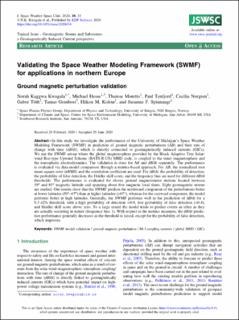Validating the Space Weather Modeling Framework (SWMF) for applications in northern Europe: Ground magnetic perturbation validation
Kwagala, Norah Kaggwa; Hesse, Michael; Moretto, Therese; Tenfjord, Paul; Norgren, Astrid Elisabet Cecilia; Tóth, Gábor; Gombosi, Tamás I.; Kolstø, Håkon Midthun; Spinnangr, Susanne Flø
Journal article, Peer reviewed
Published version

Åpne
Permanent lenke
https://hdl.handle.net/11250/2766192Utgivelsesdato
2020Metadata
Vis full innførselSamlinger
Originalversjon
Journal of Space Weather and Space Climate. 2020, 10, 33. https://doi.org/10.1051/swsc/2020034Sammendrag
In this study we investigate the performance of the University of Michigan’s Space Weather Modeling Framework (SWMF) in prediction of ground magnetic perturbations (ΔB) and their rate of change with time (dB/dt), which is directly connected to geomagnetically induced currents (GICs). We use the SWMF set-up where the global magnetosphere provided by the Block Adaptive Tree Solar-wind Roe-type Upwind Scheme (BATS-R-US) MHD code, is coupled to the inner magnetosphere and the ionospheric electrodynamics. The validation is done for ΔB and dB/dt separately. The performance is evaluated via data-model comparison through a metrics-based approach. For ΔB, the normalized root mean square error (nRMS) and the correlation coefficient are used. For dB/dt, the probability of detection, the probability of false detection, the Heidke skill score, and the frequency bias are used for different dB/dt thresholds. The performance is evaluated for eleven ground magnetometer stations located between 59° and 85° magnetic latitude and spanning about five magnetic local times. Eight geomagnetic storms are studied. Our results show that the SWMF predicts the northward component of the perturbations better at lower latitudes (59°–67°) than at higher latitudes (>67°), whereas for the eastward component, the model performs better at high latitudes. Generally, the SWMF performs well in the prediction of dB/dt for a 0.3 nT/s threshold, with a high probability of detection ≈0.8, low probability of false detection (<0.4), and Heidke skill score above zero. To a large extent the model tends to predict events as often as they are actually occurring in nature (frequency bias 1). With respect to the metrics measures, the dB/dt prediction performance generally decreases as the threshold is raised, except for the probability of false detection, which improves.
